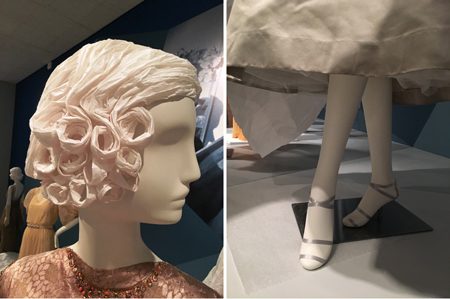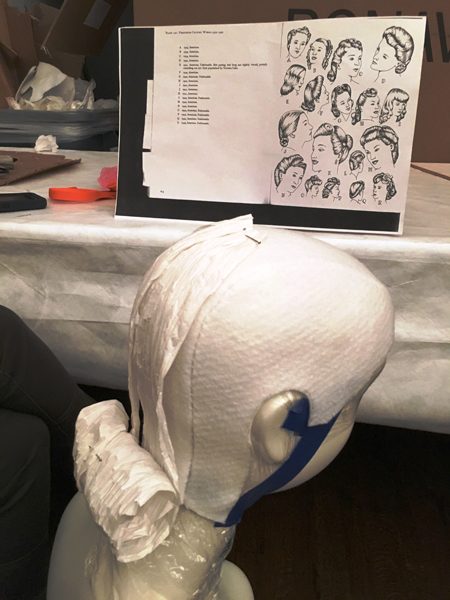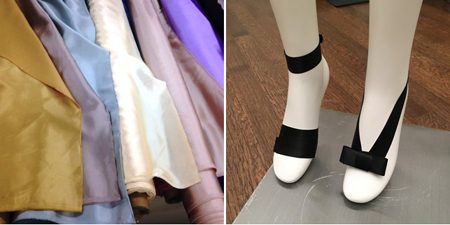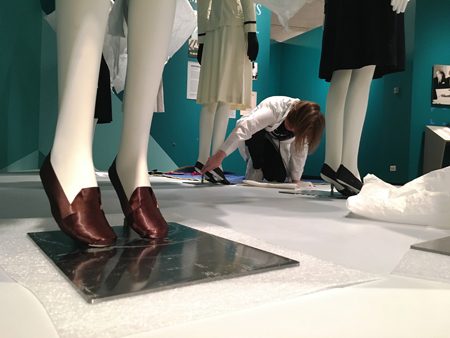As a preview to the opening of Making Mainbocher: The First American Couturier (October 22, 2016–August 20, 2017), volunteer Kristin Bernstein explains the process behind building props and determining accessories for the mannequins featured in the exhibition.
In Making Mainbocher, mannequins are dressed from head to toe and no detail is lost. A gifted sketch artist who defined luxury in the early twentieth century, Mainbocher often included accessories in many of his fashion designs to present a polished, comprehensive look to his clients. To evoke his elegant style in this exhibition, a team of volunteers and contracted specialists custom built props for each mannequin and object, including paper wigs, ribbon shoes, and even prop dresses. Similar to the background of a painted portrait, exhibition props are included to support and complement an object—rather than draw attention, they subtly add to the visual experience. These details elevate Mainbocher’s designs in the hopes that the mannequins embody his full vision.

An example of how paper wigs and ribbon shoes can fill in a mannequin’s blank presence. Behind-the-scenes photographs taken by CHM staff
Before any prop was designed, the team conducted research that included both online and print image material. In coordination with curator of costume Petra Slinkard, every prop was created to best reflect the time period of the garment it was meant to accompany.

A paper wig under construction with a visual aid in the background.
The Mainbocher garments in the exhibition range from the 1930s to the 1960s, a time span that saw dramatic changes in fashion, accessories, and hairstyles. Vintage ads in particular were very useful in providing clear images of trends, such as shoe details, and similar photography research was done for the paper wigs that were made for each individual mannequin. We consulted historic dress patterns to construct two dresses that would go under the Mainbocher outerwear.

Sorting through fabrics and conducting ribbon trials.
In addition to period accuracy, style and color were decided by what best complemented the garment. A few trials were done in order to determine the optimal materials. We gathered fabric swatches from local fabric stores and experimented with several types and widths of trim, binding, and ribbons before determining the best option. CHM conservator Holly Lundberg helped us determine if our choices were safe to use under these historic garments.

Fitting the mannequin for a prop dress.
Once we selected the materials and designs, the final step was mounting them on the mannequins. Dressing a garment for exhibition can take many hours depending on the needs of the object. Mannequins are often padded with a soft, stable material such as cotton to help them support the often-fragile garments. The prop dresses were sewn and mounted on the mannequins before the artifacts could be placed over them. All of the ribbon shoes and wigs were applied after the object was mounted onto the mannequins, so as to avoid causing stress to the garment. Working with mannequins has both benefits and challenges. Fitting a dress for a mannequin is much easier than on a human, since they don’t move or change size, but mounting ribbon shoes after the garment was in place meant there was a bit of kneeling and lying on the floor in order to manipulate and secure the ribbon. The end result, however, was worth the effort.

While the exhibition props are unlikely to steal the show, they do elevate the experience. We hope that when you visit Making Mainbocher, you will appreciate our expression of Mainbocher’s attention to detail that captivated the couture world.
Additional Resources
Learn more about Making Mainbocher: The First American Couturier